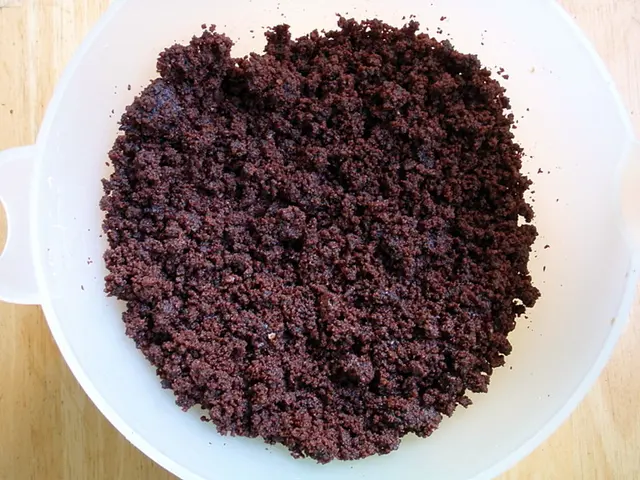Unplugging from the Sun's Wrath
Distinguishing between Age Spots and Skin Cancer: Identifying Key Differences for Proper Diagnosis
Our skin absorbs the sun's rays, and over time, that exposure can give rise to concerns. Three common conditions — age spots, skin cancer, and actinic keratosis — share some similarities, but understanding their differences is crucial for maintaining a healthy glow. Let's dig deeper!
Sun-Kissed Stains vs. the Big C
Age Spots
Considered a natural part of aging, age spots (or solar lentigines) are flat, pigmented patches that appear on sun-exposed areas. Unlike skin cancer, age spots are generally harmless[1].
Skin Cancer
Skin cancer is a serious issue — it can sneak up on you, appearing as sores or growths. There are several types, such as basal and squamous cell carcinomas, but melanoma is the most dangerous[2]. Each type has unique features, as detailed below.
Basal Cell Carcinoma
This is the most common form of skin cancer. It usually appears as a shiny, pearly, or pink bump, a red, scar-like patch, or a flat, white or yellow, waxy scar[2].
Squamous Cell Carcinoma
Squamous cell carcinoma appears as a firm, red, or scaly bump or a flat, red or brown scar-like patch[2].
Actinic Keratosis
Actinic keratosis, a precancerous condition, manifests as rough, scaly, or crusty patches on sun-exposed areas. It may be itchy, tender, or develop into squamous cell carcinoma if left untreated[3].
Spotting the Differences
Age Spots
- Small, flat, angular patches
- Yellow, brown, or gray color
- Well-defined borders
- Usually appear on sun-exposed areas
Skin Cancer
- Varied appearances depending on cancer type
- Irregular or asymmetrical shape
- Changing size, color, or texture
- Pain, itching, oozing, or bleeding
Actinic Keratosis
- Often feels rough or scaly
- Red, pink, or skin-colored patches or bumps
- May be more easily felt than seen
When to Seek Help
Always consult a healthcare professional if you observe any new, changing, or unusual marks on your skin. Early detection is vital to successful treatment and improved outcomes[4].
If a mark on your skin:
- changes color, size, or shape
- looks different from other marks
- itches, oozes, or bleeds for more than 4 weeks
It’s time to reach out to your doctor for guidance.
Time to Make it Better
Treatment varies based on the condition. Age spots can be treated cosmetically, while skin cancer requires medical intervention like surgery or radiation. Actinic keratosis is typically treated with topical creams or light-based therapies to prevent progression to cancer[4].
Armed with knowledge, remember to stay sun-safe by using sunscreen, protective clothing, and limiting sun exposure. It's never too late to take care of your skin!
[1] Skincancer.org. (n.d.) Age Spots. [online] Available at: https://www.skincancer.org/skin-cancer-information/types/basal-cell-carcinoma/basal-cell-carcinoma-faqs#:~:text=Age%20spots%20(or%20liver%20spots,doctors%E2%80%99%20offices%20or%20clinics.
[2] American Academy of Dermatology. (n.d.) Skin Cancer: Signs, Symptoms, and Types. [online] Available at: https://www.aad.org/public/diseases/skin-cancer/types
[3] Skincancer.org. (n.d.) Actinic Keratosis. [online] Available at: https://www.skincancer.org/skin-cancer-information/actinic-keratosis
[4] Healthline. (n.d.) Skin Cancer: Diagnosis and Treatment. [online] Available at: https://www.healthline.com/health/skin-cancer/diagnosis-treatment
- Age spots, a natural part of aging, are flat, pigmented patches that appear on sun-exposed areas and are generally harmless.
- Skin cancer is a serious medical condition that can appear as sores or growths, with types such as basal and squamous cell carcinomas, but melanoma is the most dangerous.
- Basal cell carcinoma usually appears as a shiny, pearly, or pink bump, a red, scar-like patch, or a flat, white or yellow, waxy scar.
- Squamous cell carcinoma appears as a firm, red, or scaly bump or a flat, red or brown scar-like patch.
- Actinic keratosis, a precancerous condition, manifests as rough, scaly, or crusty patches on sun-exposed areas, and may be itchy, tender, or develop into squamous cell carcinoma if left untreated.
- Age spots, skin cancer, and actinic keratosis share some similarities, but understanding their differences is crucial for maintaining a healthy glow and identifying potential skin issues early.
- If a mark on your skin changes color, size, or shape, looks different from other marks, itches, oozes, or bleeds for more than 4 weeks, it’s time to consult a healthcare professional for guidance.
- Treatment for age spots, skin cancer, and actinic keratosis varies based on the condition, with cosmetic treatments, medical interventions like surgery or radiation, and topical creams or light-based therapies being common approaches.








